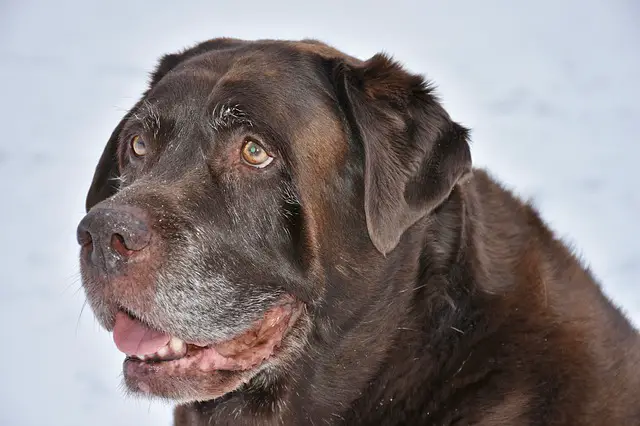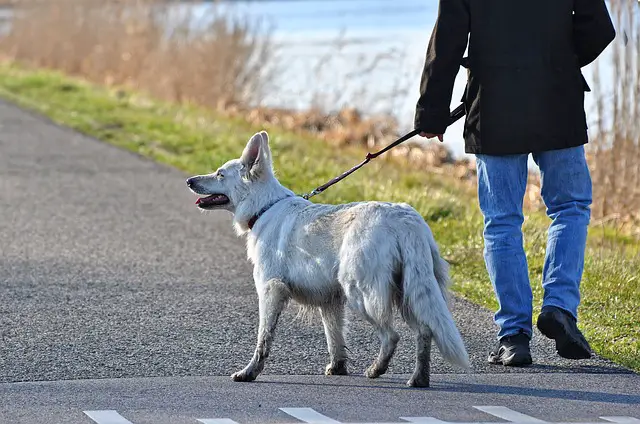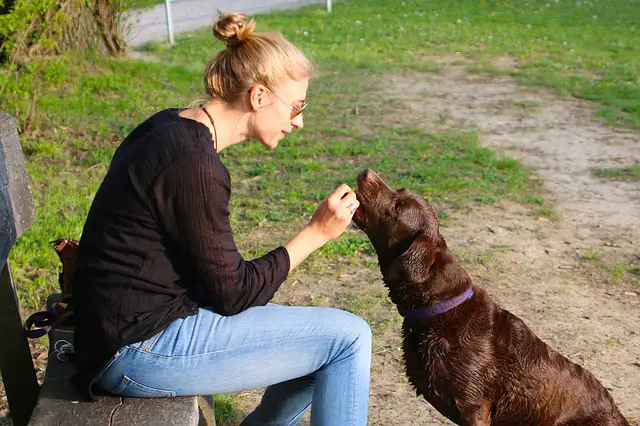
If you’ve just googled “how to get dog to eat”, then your dog is probably not eating, and we bet you’re distressed. Staying away from food for extended periods at a time can lead to starvation which could cause a dog to either fall dangerously ill or even die. So, if he won’t eat, it’s only natural that any good parent would get worried.
However, to solve the problem of inappetence, one must first find out what’s causing it, and there are myriads of possible reasons that abound.
Before we go into that, though, it’s important that we confirm that your worry is valid in the first place. For some dog parents, their fears are as a result of the fact that their dog won’t eat as much food as the guidelines on his kibble indicate.
For such parents, you want to keep in mind that values stated on dog foods, in general, are only average values. There’s nothing set in stone there and many dogs in perfect health might only eat about 60-70% of what’s actually advised on the pack. So, that shouldn’t be a cause for worry.
What should worry you is anorexia.
No, not anorexia nervosa. Just anorexia.
Table of Contents
What is Anorexia In Dogs?
According to PetMD, in dogs, anorexia refers to a complete loss of appetite. That is, your dog won’t eat at all. It’s different from anorexia nervosa which is a human eating disorder.
In dogs, anorexia is usually indicative of an underlying illness. Therefore, it is important to notify your vet once you notice your dog has been displaying a loss of appetite. Especially if you know your dog to be a healthy eater, if you notice a decline in appetite, we will advise that you contact your vet after 48 hours of consistent display of this behavior.
That said, to be completely honest, your dog can survive a few days without eating. However, it is still important to deal with the problem head-on immediately you notice it as loss of appetite is often not the problem. Rather as in many cases, it’s indicative of an underlying condition.
Before we go into the next section, check out this video below. Here, Pete the vet explains some of the possible reasons your dog might be losing his appetite like a change in routine, gastric upset, and illness. He also points out when dog owners should begin to worry about their dog’s lack of appetite.
Why Is Your Dog Not Eating?
There are a number of reasons your dog might not be interested in eating of late. Some of them include:
1. Illness

Just like in humans, illness in dogs is often accompanied by a loss of appetite, especially when accompanied with other symptoms. Even though loss of appetite might not indicate a serious illness, it’s still important to seek urgent medical attention as it could, sometimes, be a pointer to a grave illness. Grave illnesses could include cancer, systemic infections, kidney failure, liver problems, and pain.
2. Dental Disease
If your dog experiences pain when he chews, it’s only natural that he would be averse to eating. You might want to have your dog’s teeth checked for dental problems such as a loose or broken tooth, severe gingivitis, or perhaps, even an oral tumor. Excellent dental condition is important for your dog to eat well.
3. Recent Vaccination
Vaccinations save lives and we shudder to think where the world would be without them. All the same, they do have some adverse effects, even though they are usually brief and minor. One of such adverse effects is temporary inappetence in dogs.
4. Travel

Sometimes, you notice that your dog’s appetite is perfect until you both move to a new location. Sometimes, dogs get shy and uncomfortable, and won’t eat if the surrounding is unfamiliar. In other cases, it might be as a result of motion sickness too.
5. Pickiness/Behavioral Issues
Some dogs are naturally picky eaters and as such might not always eat everything you present before them. Other times, it might be that they are uncomfortable with the height at which their food bowl is, or maybe there’s a more aggressive dog around them.
Duke from Bella and Duke explains who a picky eater is and why you might not need to worry if your dog is one. He also offers tips to help manage the situation when pickiness begins to adversely affect your dog’s health.
6. Gastrointestinal Upset
Dogs are scavengers which means they can even dig in the trash and eat whatever they find there. All they need is for you to take your eyes off of them for one minute. Of course, if your dog eats rubbish, he’s bound to come down with stomach upset often.
Symptoms of such upset usually include vomiting and diarrhea which is your dog’s body’s way of eliminating the offending food. In such situations, it’s only natural if your dog loses his appetite for a bit.
Thankfully, such symptoms relieve themselves in a few days. Just keep him hydrated and contact your vet if symptoms persist after 24 hours.
7. Old Age

As dogs age, their sense of smell loses its acuteness. Also, the onset of joint pain is expected which could make walking to the food bowl painful and unpleasant for the dog.
If the problem is joint pain, then you need to take a trip to your vet. Your vet will prescribe medicines and treatments to help relieve your dog of the pain and increase his appetite as well. (Click here to read our article on joint supplements for dogs that your pup can start taking today to delay the onset of joint problems).
All this said, it’s dangerous to assume the cause of your dog’s loss of appetite without finding out first. This is because loss of appetite could very well be as a result of an illness and if this isn’t treated on time, it could cause further health complications.
What To Do If Your Dog Won’t Eat
There are a number of ways you can help your dog if he won’t eat. However, first, you must confirm with your vet what the problem is.
Now, if the reason your dog won’t eat is because of illness, your vet is most likely to recommend a prescription diet. This prescription diet will be meeting the nutritional needs of your pet while you work to address the underlying illness.
In many cases, prescription diets aren’t exactly tasty. This becomes truer if your dog is already used to people food or treats.
So, in the event that your dog does not like the prescribed diet and isn’t eating it, please do not starve in an attempt to get him to eat the prescribed food by force.
If he won’t eat the prescribed diet, talk with your vet and consider alternatives your dog could try in replacement. If it’s a severe case, your vet might get stuck with two choices.
One would be to recommend medications that stimulate the appetite. Another would be to feed your dog a liquid diet through a feeding tube or a syringe.
But that’s for illness. If inappetence is behavioral or pickiness, here are some things you could try to get your pooch to eat.
1. Check Your Food Choices
One of the first things you can do when your dog’s loss of appetite isn’t as a result of illness is to check what you’re feeding him. Make sure it isn’t spoiled or expired. Seems quite obvious but that could be the reason.
Another thing you could do is to make your dog’s food a little more appetizing. Consider foods like real meat, foods with adequate fat (the good kind), and fruit.
2. Check Your Feeding Methods
Besides that, also ensure that you’re not constantly changing your dog’s food every now and then. Your dog might not like such experiments and it might even be affecting his digestive system.
If you want to make a switch, then break your dog into the new food gradually. Start by mixing the old food with the new. Continue this until all that’s left is the new food. Sometimes, trying a new food might even be the solution as a new flavor of food is, in some cases, all that’s needed to stimulate the appetite again.
3. Take Your Dog On A Walk Just Before Mealtime

This could also help to increase your dog’s appetite. Try penciling in taking walks with your dog just before mealtimes into your dog schedule. This way, your dog begins to associate walk time with mealtime and that could help to boost appetite.
4. Change The Food/Feeding Location
It might be that your dog is nervous around other pets and can’t eat when they are there. Try creating a quiet place for him where there are no distractions or he doesn’t feel like he’s in competition with other pets.
In other cases, the trick might simply be to change the height of the bowl from which your dog eats or to change the food bowl altogether.
5. Develop A Feeding Routine And Stick With It
Develop a feeding routine with your dog by offering him his food but only for a short while before you take it away. When you do this, you teach your dog that food will only be available at certain regular times in a day. With time, this will become a routine that your dog can depend on.
Check out this video where Josh Donahue of Argos Dog Works explains why it is bad for your dog to let him feed whenever he wants.
https://www.youtube.com/watch?v=XHwPFhQQuhs
6. Stop Feeding Your Pet Scraps
If your dog shuns his own food for table scraps, that’s on you and you have to correct it immediately. It shouldn’t be surprising that your dog won’t eat his humdrum kibble anymore after he’s had a taste of the more exciting meals from your table. The best way to correct this is to stop it altogether else you risk reinforcing bad behavior.
Now, at first, your dog might be stubborn in the hopes that you’ll give in eventually. However, don’t fall for it. Stand your ground until he realizes that people food is off-limits for him.
7. Try Homemade Meals
There’s hardly any dog alive that can resist a homemade meal as long as you’re doing it right. So, you can also try that option.
8. Hand Feeding

This should be the method of last resort as it isn’t something you want to make a habit of. However, there are times when that might be the only way to get your dog to eat.
Appetite Stimulants For Dogs That Won’t Eat
If your dog has stopped eating long enough to start affecting his health negatively, then appetite stimulants might become necessary.
Usually, appetite stimulants are recommended when a dog is on medication (chemotherapy for instance), convalescing, or needs help changing to a new diet.
Here are some options your vet might recommend.
1. Rotisserie Chicken
Geriatric and sick dogs who have become picky eaters might easily be won over with rotisserie chicken. It’s a cheap and effective option as it smells heavenly to dogs and only very few dogs can say no to any meal mixed with rotisserie chicken.
A few warnings though. Do not include the skin and bones of the rotisserie chicken when feeding it to your dog. Especially if you’ve been instructed to keep your dog on a low-fat diet, then feed the white meat of the chicken only.
2. Acupunture
Acupuncture does not cure the disease, however, it can reduce the resulting inflammation, nausea, and pain.
Hence, for dogs with kidney failure, diabetes, liver failure, pancreatitis, or Addison’s disease and other such hormonal conditions, acupuncture might be the way to go. There are testimonies of sick dogs whose appetites actually picked up after an acupuncture session.
3. Mirtazapine
If natural methods don’t work, then it might be time to go pharmaceutical. Mirtazipine is one of the commonest routes to go. It’s usually prescribed if the dog is sick with cancer or on medication like chemotherapy.
Mirtazapine works by increasing serotonin levels. Therefore, it must not be administered to dogs on selective seratonin reuptake inhibitors (SSRIs).
4. Meclizine
Meclizine is an antihistamine and reduces nausea brought on by vertigo. If nausea is the reason your dog is not eating, there are other options you could try including maropitant which you can easily get from your local vet.
5. Ghrelin Receptor Agonist
This is a new drug that works by mimicking the effects of ghrelin. Ghrelin is a hormone in dogs and humans that make them feel hungry. Like ghrelin, this medication binds to ghrelin receptors in the body. This causes the body to trigger the feeling of hunger int the body.
6. CBD Products
If these are legal where you live, you can get some CBD products for pets from your vet. These products work by reducing pain and increasing the appetite.
Please, note that the CBD you get from hemp is not THC. Plus, marijuana is poisonous to pets. So, always ask your vet for recommendations before you go on and get any CBD product.